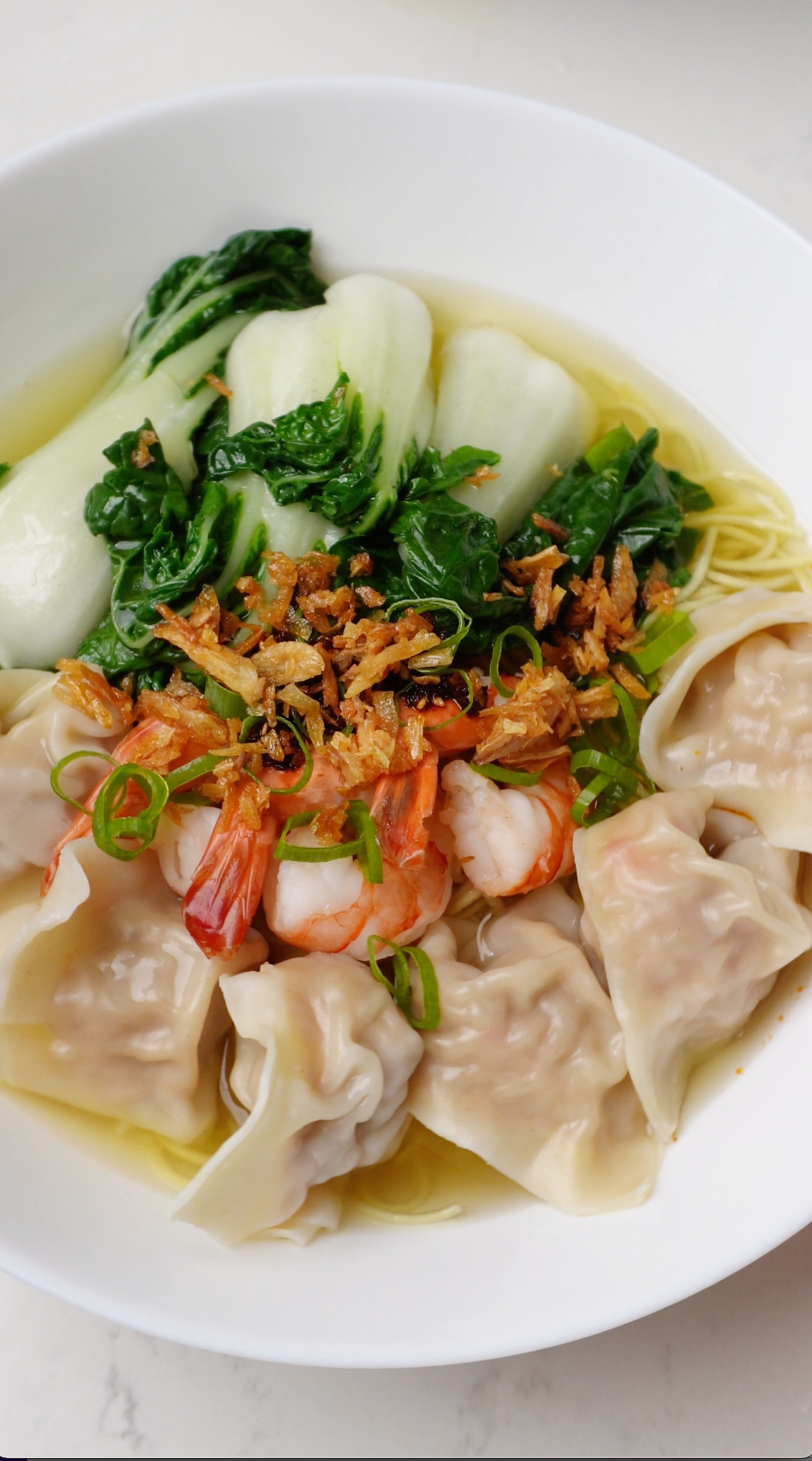

· By Sylvia Nguyen
Vietnamese Wonton Soup
Today, we bring you a tasty and authentic recipe for Vietnamese Wonton Soup (Mi Hoanh Thanh). 
Ah, Fall! That cozy season that nudges us towards the comforting embrace of warm meals. And what better dish to curl up with than a hearty bowl of Vietnamese Wonton Soup (Mi Hoanh Thanh)
Wontons Across Cultures
Wontons, familiar yet varied across East Asian dishes, play a key role in our soup today. Though similar to dumplings, they bring their own flair to the table with distinct shapes and textures.
Flexible and Flavourful Filling
Our wonton filling combines the savoury goodness of shrimp and minced pork. But hey, if meat isn’t your thing, a shrimp-only filling works wonderfully too!
Noodle Choices
Egg noodles, with their slightly chewy texture, perfectly complement the rich flavors and add a satisfying bite to our soup.
Wonton Wrapping: No Stress!
No need to stress over the wonton wrap – as long as the filling stays inside, you’re doing it right!
If you’ve ever watched a skilled chef wrap wontons, it might seem like an intricate art form – and it can be! However, in our kitchen, we’re embracing a no-stress approach to wrapping wontons.
The goal is straightforward: keep the scrumptious filling neatly tucked inside the wrapper until it’s ready to be devoured. Traditional methods involve a series of folds, pinches, and tucks to create that classic wonton shape, but if origami isn’t your strong suit, fret not.
A simple method is the “triangle fold.” Just place a dollop of filling in the center of the wrapper, wet the edges with a bit of egg wash, and fold it diagonally to create a triangle, pressing the edges together to seal the filling inside. Voilà! A perfectly functional wonton.
If you’re feeling a bit more adventurous, after making the triangle, you could try bringing the two opposite corners together, giving you a tortellini-like shape – another classic wonton form. But truly, whether your wontons are aesthetically pleated or casually wrapped, they will taste just as delightful bobbing in your savoury broth.



Broth Made Easy
The homemade broth keeps things simple: Pork bones, onions, ginger, rehydrated shrimp, a dash of rock sugar, a touch of MSG, and fish sauce. Slow-cooked to perfection and incredibly easy to make!
Vibrant Veggies and Toppings
For an extra pop of colour and crunch, we’re adding steamed bok choy, chopped green onions, chili crisp of your choice, and a sprinkle of fried shallots.
Let’s Get Cooking:
Wonton Filling:
- 400g ground pork
- 200g shrimps
- 4 scallion stems (white part)
- 2 eggs
- Wonton wrappers (2 packs)
- 1 tbsp oyster sauce
- 1 tsp each of garlic powder
- 1 tsp chicken bouillon,
- 2 tsp sugar
- 1 tsp sesame oil
- 1-2 tsp salt
- plenty of pepper
Broth Ingredients:
- 4.5 quarts of water
- 1 pound of pork bones
- 20g rock sugar
- 1 whole onion
- 2-inch ginger
- 2 tbsp dried shrimp
- 1/3 cup fish sauce
- 3 tbsp chicken bouillon
- 1/4 tsp MSG
Toppings and Noodles:
- 2 bags of egg noodles
- 100 grams cooked shrimp
- Green onions and fried shallots for garnish
- A dash of your favourite chili crisp oil
Instructions:
1. Broth Basics:
- Begin by placing your pork bones into a large pot filled with enough water to cover them.
- Bring the water to a boil and allow the bones to cook for about 15 minutes. This initial boil helps to remove any impurities from the bones, ensuring a clear broth.
- After 15 minutes, remove the bones, discard the water, and rinse the bones thoroughly under cool running water.
2. Building a Flavorful Base:
- Place your cleaned pork bones back into the pot and cover them with fresh water (around 4.5 quarts or as needed).
- Add a whole onion (peeled and halved) and a chunk of ginger (approximately 2 inches, smashed or sliced) to the pot. These aromatic vegetables will infuse the broth with their distinctive flavors as it simmers.
- Incorporate dried shrimp for an umami punch and a piece of rock sugar to add a subtle sweetness, balancing the savory notes of the other ingredients.
3. Simmer to Perfection
- Bring your pot to a gentle boil, then reduce the heat to maintain a low simmer. Allowing the broth to cook slowly and gently is crucial for extracting flavors without making it cloudy.
- Keep the pot partially covered and let the ingredients meld together, simmering for a minimum of 4-5 hours. The longer you allow the broth to simmer, the more robust and developed the flavors will become.
- Periodically skim off any foam or fat that rises to the surface during simmering to maintain clarity and purity in your broth.
4. Seasoning and Finishing Touches:
- After simmering, strain the broth through a fine-mesh sieve to remove all the solid components, leaving you with a clear, flavorful liquid.
- Place the strained broth back on the stove and season it with fish sauce, a touch of MSG (if using), and additional salt if needed, tailoring it to your preferred flavor profile.
- Allow the broth to simmer for an additional 15-20 minutes after seasoning, for the flavors to harmonize.
5. Wonton Prep: Mix minced shrimp, scallions, pork, and all seasonings together. Wrap a small amount in each wrapper, seal with egg, boil until they float, and set aside.
6. Noodle Time: Cook your egg noodles according to the package instructions.
7. Build Your Bowl: Add noodles and wontons to a bowl, pour in the broth, and top with bok choy, green onions, and fried shallots.
And there you have it – a warm, comforting bowl of Mi Hoanh Thanh, ready to be savoured. Happy cooking. YOMMM 🍜